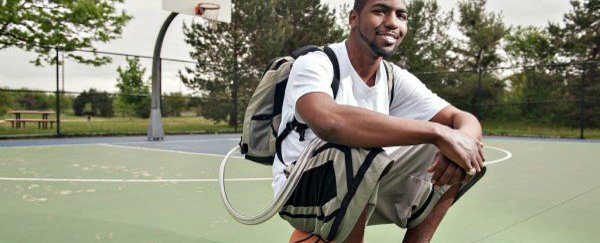In 2016, a 25-year-old American man received a full heart transplant… but not before surviving for more than a year without a human heart inside his body.
Instead, Stan Larkin wore an 'artificial heart' in a backpack 24/7 for 555 days, which pumped blood around his body and kept him alive. The success of the procedure suggests that the device could be used to sustain other patients with total heart failure while they're waiting for a donor.
Back in 2014, Stan became the first patient in Michigan to be discharged with the artificial heart device, which is known as a 'Syncardia'.
He and his brother Dominique had both been diagnosed as teenagers with familial cardiomyopathy, which is a genetic heart condition that can cause heart failure without any warning - it's one of the leading causes of death in athletes.
After years on the donor waiting list, Stan - and eventually his younger brother Dominique - had their hearts removed and were fitted with the Syncardia device.
"They were both very, very ill when we first met them in our intensive care units," said the surgeon behind the transplant, Jonathan Haft, from the University of Michigan Frankel Cardiovascular Centre. "We wanted to get them heart transplants, but we didn't think we had enough time. There's just something about their unique anatomic situation where other technology wasn't going to work."
While other devices such as implantable defibrillators can help with partial heart failure, Syncardia is used when both sides of the heart fail.
Dominique only needed to use the technology for a few weeks before receiving a full heart transplant. But Stan had to wait more than a year, and instead of staying in hospital, he was fitted with the Freedom® portable driver so he could go home in the meantime.
At the time, no one knew how much he'd be able to do with it. The portable device comes in the form of a 6-kg (13.5 pound) backpack that's connected to the patient's vascular system, to keep oxygenated blood pumping around the body.
It's not the most versatile thing to have on you 24/7, and Stan reported not being able to hold his daughters or give them piggy back rides. But he did manage to continue playing basketball - a total surprise to his doctors.
"This wasn't made for pick-up basketball," said Haft. "Stan pushed the envelope with this technology … He really thrived on the device."
Stan received his donor heart on 9 May 2016, and fully recovered from the procedure. He shared his story, which he called an "emotional rollercoaster", with the press to raise awareness about the 5.7 million other Americans living with heart failure, and the need for heart donors.
"You're heroes to all of us," David J. Pinsky, director of the Frankel Cardiovascular Centre, said of Stan and Dominique. "The fact that you take your story public and allow us to teach others makes a difference. You'll make a difference for a lot of patients. You'll make a difference to the doctors of the future. We thank you for allowing us to share your story and your bravery in sharing it."
A version of this story was originally published in 2016.
